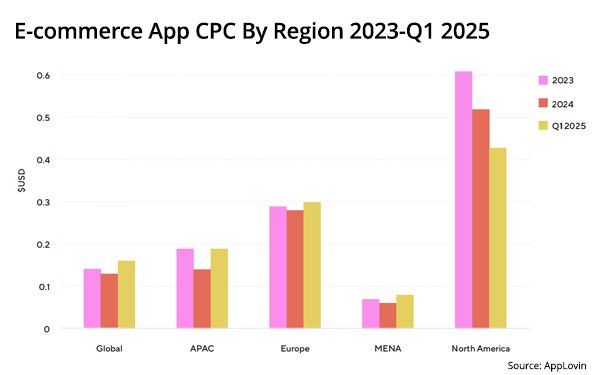
Adjust, an AppLovin company, revealed a shift in how
brands approach gaining app users when supported by artificial intelligence (AI).
The combination of AI in shopping apps lets brands key into behavioral changes and focus on higher-value
consumers based on economic challenges or tighter privacy regulations. It's changing how marketers test, segment, and optimize campaigns.
When implemented correctly, AI can help to
identify new signals and insights, enable an enhanced level of hyper-personalization, and facilitate fast and confident decisions. In the leadup to the fourth quarter in 2025, holiday
season, Adjust released data in its Shopping App Insights Report 2025 to detail how targeting will continue to change this year.
The data pulled and analyzed from a list of 45 countries
across Adjust’s top 5,000 apps it supports and the total dataset of all apps tracked by the company between January 2023 and June 2025.
advertisement
advertisement
North America recorded the highest ecommerce app
cost-per-click, $0.43 in Q1 2025, despite a continued downward trend from $0.61 in 2023. Europe recovered slightly to $0.3 after dipping to $0.28 in 2024. In APAC, CPC returned to $0.19 after a drop
the previous year. MENA also saw a rebound to $0.08, following a dip to $0.06 in 2024.
AI will change performance, but at least for now ecommerce app installations in the first half
of 2025 declined 14% year-over-year (YoY) globally, the data shows, as the number of sessions rose 2%. The data suggests it indicates apps are attracting fewer but more engaged users. It’s
evidence of reattribution in share for ecommerce apps, which rose 29% in the first half of the year, compared with the year-ago time period in 2023.
Emerging markets lead mobile growth
patterns. Latin America led the shopping app market with 18% installs of shopping app and 27% of sessions YoY in the first half of 2025. APAC also demonstrated strong momentum with more than 13%
in shopping app installs more than 2% of sessions.
Europe, MENA and North America experienced slowdowns, suggesting advertisers and marketers are seeing market saturation and a change in
consumer behaviors.
Shopping apps accounted for more than three-quarters of all global ecommerce installs from the first half of 2024 through the first half in 2025, but generated just 36% of
sessions.
The data reveals a gap in sustaining user engagement. Marketplace apps drove 60% of sessions, despite representing only 20% of installs. Session lengths for ecommerce apps also
shortened in the first half of 2025, averaging 9.89 minutes, down from 10.23 minutes in 2024 globally.
Marketplace apps like Amazon posted the longest average of time spent in the app, 10.69
minutes. These apps also led with 25% first-day retention rates, while ecommerce apps dropped 13%.
Black Friday, Christmas, and other holidays will become more interesting this year as brands
test creatives and expand into spaces that include connected TV, chatbot-led commerce, and augmented reality try-ons. Preparing for this time period allows advertisers to consider retention—the
more users kept now during this transition, the better the performance will be throughout the rest of the calendar.
Shopify Magic, for example, leverages AI to enhance inventory and sales
forecasting, saving more than 20 hours monthly and increasing traffic by up to 40%, according to the report, citing an article by Reuters. AI helps in automating everything from bidding to audience
targeting, and budget reallocation in real-time based on immediate performance data.
Overall shifts Adjust observes in the mobile shopping industry in 2025 include AI across the funnel, from
creative generation to predictive targeting and attribution modeling.
Omnichannel has become a default mode, with the mobile web emerging as a high-intent entry point requiring seamless flows
from web-to-apps. Shopping apps averaged seven partners per app in the first half of 2025, up from six in 2023.
But no one can deny that the industry continues to go through rapid
innovation that’s reshaping the path to purchase.